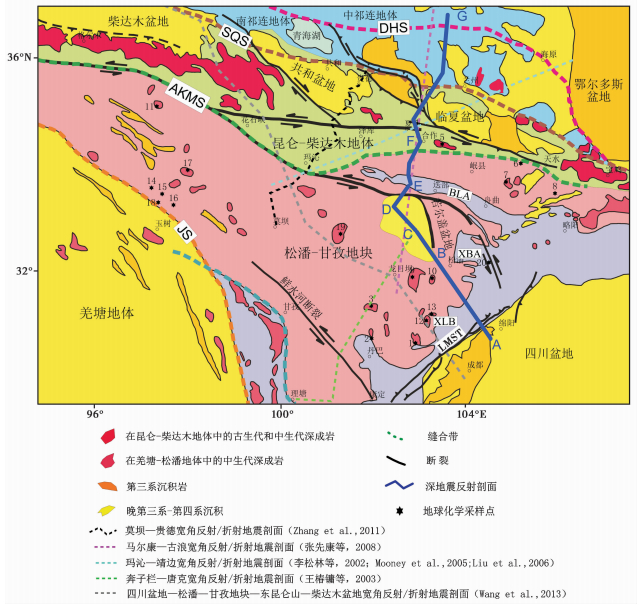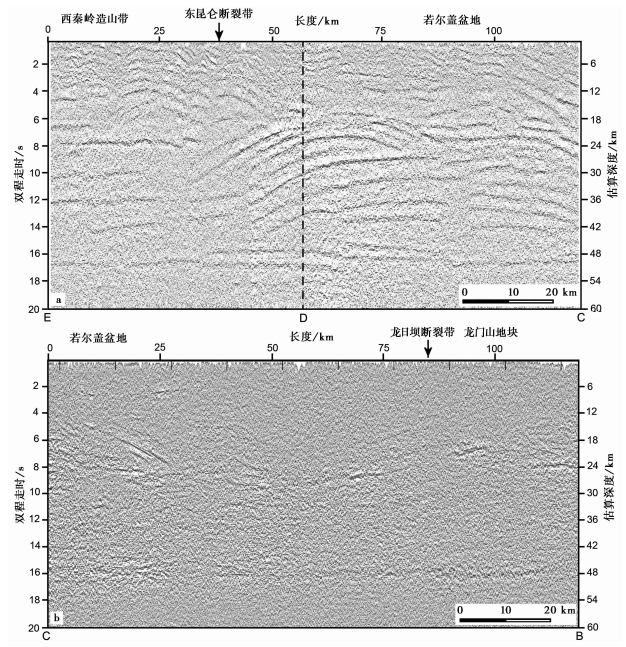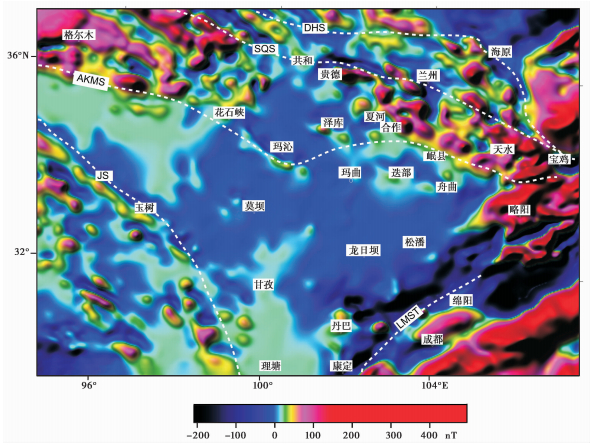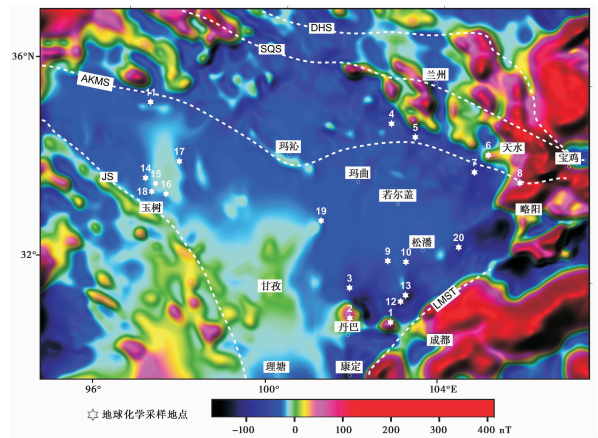松潘—甘孜地块位于青藏高原东北部,总体呈倒三角形状,夹持于东昆仑—西秦岭造山带、羌塘地体,以及龙门山逆冲推覆带之间(图 1)。该地块大致南以金沙江缝合带为界,北以阿尼玛卿—木孜塔格缝合带为界,东以龙门山断裂带为界与四川盆地相接(Yin and Harrison,2000;张季生等,2012)(图 1)。

|
图 1 松潘—甘孜地块及邻区构造地质简图 AKMS. 阿尼玛卿—昆仑—木孜塔格缝合带;SQS. 南祁连缝合带;DHS. 党和南山缝合带;JS. 金沙江缝合带;LMST. 龙门山逆冲推覆带;BLA. 白龙江隆起;XBA. 雪宝顶隆起;XLB. 雪隆包;蓝线ABC段为龙门山—松潘深地震反射剖面(BC段为本文所展示的剖面);蓝线CDEF线段表示松潘—西秦岭深地震反射剖面(CDE段为本文所展示的 剖面);蓝线FG段为西秦岭造山带—阿拉善地块南缘深地震反射剖面 Fig.1 Tectonic map of the Songpan-Garze orogeny and adjacent areas |
松潘—甘孜地块被三叠纪巨厚复理石沉积所覆盖(Sengör,1987;许志琴等,1992;Chen et al.,1995;Yin and Harrison,2000;Weislogel,2008),其内部还存在二叠纪—新生代的酸性岩体(四川省地质矿产局,1991)。此外,地块周边有元古代地层出露: 南部,丹巴背斜构造核部出露新元古代地层;东部,沿着龙门山逆冲推覆带出露雪隆包变质杂岩体(Zhou et al.,2002,2006;张季生等,2012);北部,昆仑断裂带以北的白龙江隆起出露元古代地层(甘肃省地质矿产局,1989);在若尔盖以东约100 km的雪宝顶隆起,三叠系覆盖在元古代和古生代地层之上(四川省地质矿产局,1991)。
松潘—甘孜地块基底的属性对于探讨青藏高原的形成至关重要,因此备受国内外学者关注。任纪舜等(1980)提出阿坝—松潘一带存在一个中间地块,称其为“松潘地块”或“阿坝地块”,并推测这个地块的基底为一个古老的结晶基底。Sengör(1984)认为松潘—甘孜造山带下可能缺失陆壳岩石圈,其上的复理石沉积序列可能直接覆盖在俯冲带的洋壳之上。Burchfiel et al.(1995)提出松潘—甘孜地块的基底是扬子陆块的一部分,三叠纪沉积岩直接覆盖于华南古生代浅海层序之上。Yin and Harrison(2000)提出松潘—甘孜地块前身属于特提斯残留洋盆。
近十多年来,国内外学者在青藏高原东部特别是松潘—甘孜地块对元古宙—新生代构造、变质和岩石年代学进行了深入研究,并取得一系列进展(Zhou et al.,2002;Roger et al.,2004,2010;Harrowfield and Wilson,2005;Zhou et al.,2006,2008)。Roger et al.(2010)综合分析了十多年的构造研究,提出了松潘—甘孜及邻区地质演化的新模式,认为松潘—甘孜褶皱带不是形成于典型的碰撞带背景下,因为闭合洋盆的三角形状和洋盆内存在的巨量沉积不允许完全的陆陆碰撞。这些前期存在的地质条件对青藏高原东部的构造继承起到了重要作用(Roger et al.,2010)。
然而,在松潘—甘孜地块内部,基底岩石仅仅出现在几个地区周缘的褶皱带中。在内部三叠系广泛覆盖区,松潘—甘孜地块的基底属性仍然不确定。
为了揭示松潘—甘孜地块的岩石圈结构,探讨其基底属性,本文利用松潘—西秦岭造山带和松潘—龙门山两段深地震反射剖面揭示的地壳结构特征,并结合深地震测深剖面、宽频地震资料、区域航磁异常和花岗岩同位素地球化学资料等综合研究结果(李松林等,2002;王椿镛等,2003;Wang et al.,2003;高锐等,2006a,2006b;张先康等,2007,2008;Wang et al.,2010;高锐等,2011;Zhang et al.,2011;张季生等,2012),重新探讨了松潘—甘孜地块基底的构造属性。
1 深地震反射剖面反射特征与解释 1.1 深地震反射剖面资料为揭示松潘—甘孜地块地壳深部细结构,项目组用近10年的时间完成了3条深地震反射剖面: 东南端起于四川盆地西北缘,穿过松潘—甘孜地块、西秦岭造山带、临夏盆地,北至阿拉善地块南缘(图 1 蓝线ABC段为龙门山—松潘剖面,CDEF段为松潘—西秦岭剖面,FG段为西秦岭—阿拉善地块南缘剖面)。自剖面完成以来,高锐等(2006)利用松潘—西秦岭剖面的常规处理结果对松潘和西秦岭下地壳性质和结构进行了初步讨论;Wang et al.(2011)利用松潘—西秦岭剖面特殊处理结果对东昆仑断裂的几何形态和构造性质做了解释;Guo et al.(2013)利用龙门山—松潘剖面对青藏高原东缘及龙门山断裂带的隆起机制及其次生灾害进行了研究。本文利用的是穿过若尔盖盆地的深地震反射剖面(图 1 中蓝线BC段和CDE段)。
1.2 深地震反射剖面解释根据深地震反射特征的不同(图 2a),研究区地壳分为上地壳(约6.0~7.0 s以上,双程走时,下同)和中-下地壳(约7.0 s至莫霍面): 在上地壳,主要以层状反射波组为主,展现为等间隔的紧闭褶皱;在中-下地壳,以强的倾斜反射和穹隆状反射为主,表现为宽缓褶皱或微微上隆的构造特征;在下地壳,表现为弱反射的特征。剖面显示,约以6.0~7.0 s为界(按照地壳平均速度6.0 km/s估算,埋深约为18.0~21.0 km,下同),上地壳与中-下地壳之间存在一个逆冲拆离断层(约6.0~7.0 s),使得上地壳与中-下地壳变形解耦。上述深地震反射剖面的结果也得到深地震测深剖面的证实(张先康等,2007,2008),其结果显示: 青藏高原东北缘地表速度较高,约为3.2~4.2 km/s,主要为三叠纪裸露风化岩层;在深度为20~23 km之间发现速度界面(P1),其上覆介质的平均速度为5.7~5.8 km/s;在若尔盖盆地内,P波速度纵向梯度变化不大,横向比较均匀。

|
图 2 深地震反射偏移剖面 a. 松潘—西秦岭段剖面(位置见图1蓝线EDC);b. 龙门山—松潘剖面(位置见图1中蓝线CB) Fig.2 Deep seismic reflection migration section |
上地壳的反射特征主要反映了沉积盖层,中-下地壳的反射特征主要反映了前古生界的特征(Wang et al.,2011)。深地震反射剖面的反射特征显示,若尔盖盆地中部约6.0 s(约为18 km)之下的中-下地壳(图 2a)受到两侧的挤压作用形成微隆起,其北部向北倾斜插入到西秦岭造山带之下,其南部存在南倾的反射层,这种南倾的反射特征在松潘—龙门山深地震反射剖面(Guo et al.,2013;图 2b)同样存在,并存在近水平的反射层(图 2b)。两条剖面相对单一的反射特征显示盆地内中-下地壳变形较弱,我们推测若尔盖盆地内部还保留着刚性地块的特征。图 2b中显示的若尔盖盆地南侧中-下地壳存在南斜的强反射波组,可解释为由于扬子地块总体自南东向北西挤压推覆而形成的叠瓦状逆冲推覆构造,且在地壳深部被龙日坝断裂所截断(Guo et al.,2013)。
莫霍面反射出现在16.0~17.0 s 之间(图 2),局部(盆山结合带)出现在18.0 s(图 2a),表现为近水平的略向北倾的层状多组强反射特征,是地壳和地幔的明显分界面。深地震反射剖面得到的莫霍面深度与其邻近位置的人工源深地震测深资料结果基本一致: 张先康等(2007,2008)根据马尔康—碌曲—古浪剖面(图 1)揭示地壳厚度一般为48~51 km,松潘地区的地壳厚度约为50 km;王椿镛等(2003)根据奔子栏—唐克人工源深地震测深剖面(图 1)揭示唐克段的地壳厚度为52 km。
2 航磁异常的分布特征与解释本文所用的航磁数据为在航遥中心购买的 1︰50万数据,点、线距均为5 km。
松潘—甘孜地块的磁场特征主要为-5~15 nT低缓磁异常,中间有岩体引起的短波长局部异常(图 3)。整个低缓磁场区近似为不规则的多边形,四周被强度及形态不同的正磁异常所包围,这些正磁异常分别与松潘—甘孜地块四周的陆块相对应(张季生等,2012)。北部边界大致沿东昆仑断裂带南缘,东部边界为龙门山逆冲推覆带,西南部边界大致沿金沙江断裂带(张季生等,2007,2012)。

|
图 3 松潘—甘孜地块及邻区航磁异常图 Fig.3 Aeromagnetic anomalies in the Songpan-Garzi region and adjacent areas |
玛沁南到玛曲长约为200 km、宽为20 km的北西向磁异常,异常强度小于40 nT。该异常与阿尼玛沁蛇绿岩带相对应,没有向东部延伸。
磁异常在四川盆地以高值正异常为主,异常强度达550 nT,呈带状或块状分布,其展布方向主要为北东向。在其北东部出现走向为北东向的负异常,推测其为该高值正异常的伴生异常。这个异常的一部分出现在我们研究区的东南部。
沿龙门山逆冲推覆带出现北东—南西向负磁异常。这个负异常长约为200 km,异常最小值为-280 nT。该负异常被解释为在地壳中出现反磁化的结晶杂岩(王懋基,1994;Zhang et al.,2010)。
由于受斜磁化的影响,航磁异常的特征位置会发生偏移,因此,对航磁异常进行了化极计算。为了滤掉岩体引起的短波长局部异常,清晰地显示磁场的分区特征,进行了向上延拓5 km的计算(张季生等,2007,2012)。计算结果表明(图 4): 整个松潘—甘孜地块同处于同一低缓的弱磁异常区内,我们推测不仅在若尔盖盆地的下地壳,而且在整个松潘—甘孜地块下地壳都存在弱磁性的基底(张季生等,2012)。

|
图 4 松潘—甘孜地块及邻区化极向上延拓5 km航磁异常图 Fig.4 Reduced-to-pole aeromagnetic anomalies after extending upward by 5 km |
岩石磁性研究结果 国家地质总局航空物探队. 1978. 四川省和青海省航空磁测报告. 四川省地质矿产局物探队. 1991. 四川省重力航磁异常综合研究报告. 甘肃省地质矿产局物探队. 1994. 甘肃省西秦岭地区地球物理场研究报告.(宋鸿彪,1994)表明: 以碎屑岩和碳酸盐岩建造分布的沉积岩磁性最弱,属无磁或微弱磁性(张季生等,2012);变质岩为弱磁性且不均匀,元古代变质岩的磁化率为8×10-6~84×10-6 4πSI,剩余磁化强度为1×10-3~102×10-3 A/m。由此可见,我们推断在松潘—甘孜地块下地壳存在元古代变质基底,且局部出露。
3 花岗岩同位素地球化学的佐证花岗岩的地球化学特征记录着深部过程的信息,同时花岗岩的地球化学示踪对揭示地壳物质组成有重要的意义(雷裕红等,2006)。晚二叠世末—早侏罗世,由于松潘—甘孜地块和昆仑—柴达木地体间的洋壳沿阿尼玛卿缝合带由南向北的俯冲、碰撞造山作用产生了大量花岗岩(许志琴等,1996)。这期岩浆作用主要发生在243~185 Ma,峰期出现在208 Ma左右(Cai et al.,2009)。以阿尼玛卿缝合带为界,南北地块花岗岩岩浆侵入活动特征存在明显差异(图 1),缝合带以北花岗岩岩浆侵入活动强烈,形成著名的东昆仑花岗岩带;缝合带以南花岗岩岩浆侵入活动较弱,主要集中出露于松潘—甘孜地块的中至东部,有为数不多的花岗岩体呈分散的岩株、岩基状产出(雷裕红等,2006)。总结前人在松潘—甘孜地块及邻区花岗岩同位素地球化学研究成果(Roger et al.,2004;张宏飞等,2005;雷裕红等,2006;Zhang et al.,2006;赵永久等,2007;Cai et al.,2009;Roger et al.,2010;De Sigoyer et al.,2014),可以得出: 从松潘—甘孜地块西部和西北部(西秦岭造山带南部)的花岗岩类地球化学和Sm-Nd同位素组成特征可以看出,ISr 值为0.7053~0.71197,εNd(t)值为-0.44~-10,表明它们可能是角闪石脱水熔融诱发镁铁质下地壳岩石部分熔融的产物,岩浆形成过程中可能有富集地幔物质的加入和中地壳物质的混杂。年代学与微量元素特征表明它们形成在后碰撞构造背景下。根据松潘—甘孜地块及邻区花岗岩类模式年龄分布,我们了解到Nd模式年龄分布为0.76~2.0 Ga,属于元古代(见表 1),这些花岗岩类的源区性质指示了松潘—甘孜地块西部具有未出露的大陆基底。扬子地块内部黄陵和汉南高地出露的花岗岩显示了早元古代的碎屑锆石年龄,说明扬子地块具有早元古代基底(Huang,1993;Zhang et al.,2001)。从Sr、Nd同位素特征来看,松潘—甘孜地块基底与其西部羌塘地体基底岩石的同位素特征差异较大,而是类似于地块东部扬子地块基底岩石的同位素特征,且在基底年龄方面与扬子板块结晶基底相近(Zhang et al.,2006),具有扬子地块的属性。
| 表 1 松潘—甘孜地块中三叠纪花岗岩Sm-Nd 同位素数据 Table 1 Sm-Nd isotope data of Triassic granitoids within the Songpan-Garze block |
另外,胡健民等(2005)在金川附近的花岗岩中发现的继承锆石年龄数据(SHRIMP U-Pb)为804±7 Ma和2026±20 Ma。Weislogel(2008)报道在松潘—甘孜地块南部发现来自两个样品的元古代锆石年龄数据为880~740 Ma,其中一个样品为花岗岩(E06),另一个为在地层夹层的火山岩(MTZag5)。
除此之外,前人研究结果显示扬子克拉通酸性火成岩的Isr 值为0.706~0.725,εNd(t)值为-17~+1,除崆岭地区出现少数模式年龄在3.2~2.75 Ga外,TDM 值均展布于2.2~0.7 Ga(Chen and Jahn,1998;Qiu and Gao,2000;Greentree and Li,2008)。
这些数据结果表明,继承锆石或者来自周围的沉积地层,或者来自地壳增厚,或者岩浆活动中卷入的扬子基底。
4 讨论与结论松潘—甘孜地块中生代早期花岗岩类地球化学特征和Sr-Nd同位素组成特征反映它们的岩浆来自地壳物质的部分熔融。因此,松潘—甘孜地块花岗岩类的源区组成可用来指示松潘—甘孜地块西部地壳基底的组成(张季生等,2012)。
扬子陆块地壳主体形成于元古代。研究区花岗岩类Nd同位素模式年龄和SHRIMP锆石年龄测定结果表明,构成松潘—甘孜地块基底的岩石主要形成于元古代,其反映的地壳生长特征与扬子地块基本一致,表明松潘—甘孜地块的基底具有亲扬子地块的构造属性。
Mooney et al.(2005)报道沿青藏高原东北部折射地震剖面(图 1)在中上地壳获得的泊松比为0.24~0.25,表明其主体为长英质组分。在下地壳,以昆仑断裂为界,断裂以北泊松比为0.29,下地壳纵波速度值为6.4~6.8 km/s;断裂以南(松潘—甘孜地块)泊松比为0.26,下地壳纵波速度值为6.4~6.7 km/s(Liu et al.,2006)。Wang et al.(2013)利用1 600 km长的深地震测深剖面(图 1)显示,松潘—甘孜地块的下地壳泊松比为0.26,纵波速度为6.9 km/s。Vergne et al.(2002)利用玉树—共和剖面远震资料得到松潘—甘孜地块地壳平均速度比为1.72~1.74,泊松比为0.24~0.25。Xu et al.(2014)利用松潘—甘孜地块—祁连地块的宽频地震数据接收函数的结果显示,松潘—甘孜地块地壳纵横波平均速度比为1.76~1.85,泊松比为0.26~0.29。根据Christensen and Mooney(1995)及 Zandt and Ammon(1995)提出的标准,这样的泊松比和纵波速度值表明青藏高原东北部特别是松潘—甘孜地块的下地壳为中性成分。Zhang et al.(2011)利用380 km长的莫坝—贵德深地震测深剖面(图 1)得到基底的P波速度≥5.9 km/s,认为松潘—甘孜基底属于扬子基底;所获得的地壳速度结构揭示松潘—甘孜地块为陆壳基底而不具备洋壳的特征(图 1)。从地球物理观察和地球化学特征的角度,在松潘—甘孜地块下方并没有发现存在洋壳的信息。
通过深地震反射剖面、深地震测深资料、宽频地震数据、航磁异常和花岗岩同位素地球化学资料综合研究,我们认为松潘—甘孜地块具有陆壳克拉通的性质,元古代的变质基底,构造上应属于扬子板块的一部分。
致谢 本文得到洪大卫研究员的指导和帮助,在此表示衷心的感谢。
| [1] | 甘肃省地质矿产局. 1989.甘肃省区域地质志.北京:地质出版社. 1-691. |
| [2] | Bureau of Geology and Mineral Resources of Gansu Province. 1989. Regional Geology of Gansu Province. Beijing:Geological Publishing House. 1-691. |
| [3] | 四川省地质矿产局. 1991.四川省区域地质志.北京:地质出版社. 1-732. |
| [4] | Bureau of Geology and Mineral Resources of Sichuan Province. 1991. Regional Geology of Sichuan Province. Beijing:Geological Publishing House. 1-732. |
| [5] | 高锐,马永生,李秋生等. 2006a. 松潘地块与西秦岭造山带下地壳的性质和关系--深地震反射剖面的揭露.地质通报, 25(12):1361-1367. |
| [6] | Gao Rui, Ma Yongsheng, Li Qiusheng et al. 2006a. Structure of the lower crust beneath the Songpan block and West Qinling orogen and their relation as revealed by deep seismic reflection profiling. Geological Bulletin of China, 25(12):1361-1367. |
| [7] | 高锐,王海燕,马永生等. 2006b. 松潘地块若尔盖盆地与西秦岭造山带岩石圈尺度的构造关系--深地震反射剖面探测成果.地球学报, 27(5):411-418. |
| [8] | Gao Rui, Wang Haiyan, Ma Yongsheng et al. 2006b. Tectonic relationships between the Zoige Basin of the Song-Pan block and the West Qinling orogen at lithosphere scale:Results of deep seismic reflection profiling. Acta Geoscientica Sinica, 27(5):411-418. |
| [9] | 高锐,王海燕,王成善等. 2011. 青藏高原东北缘岩石圈缩短变形--深地震反射剖面再处理提供的证据.地球学报, 32(5):513-520. |
| [10] | Gao Rui, Wang Haiyan, Wang Chengshan et al. 2011. Lithospheric deformation shortening of the northeastern Tibetan Plateau:Evidence from reprocessing of deep seismic reflection data. Acta Geoscientica Sinica, 32(5):513-520. |
| [11] | 胡健民,孟庆任,石玉若等. 2005. 松潘-甘孜地体内花岗岩锆石SHRIMP U-Pb定年及其构造意义.岩石学报, 21(3):867-880. |
| [12] | Hu Jianmin, Meng Qingren, Shi Yuruo et al. 2005. SHRIMP U-Pb dating of zircons from granitoid bodies in the Songpan-Ganzi terrane and its implications. Acta Petrologica Sinica, 21(3):867-880. |
| [13] | 雷裕红,马昌前,王国灿. 2006. 巴颜喀拉沉积盆地基底为扬子地台西缘的一部分:来自花岗岩的证据.高校地质学报, 12(3):298-309. |
| [14] | Lei Yuhong, Ma Changqian and Wang Guocan. 2006. The basement of Baryan Har Basin is a part of western Yangtze platform:Evidence from granites. Geological Journal of China Universities, 12(3):298-309. |
| [15] | 李松林,张先康,张成科等. 2002. 玛沁-兰州-靖边地震测深剖面地壳速度结构的初步研究.地球物理学报, 45(2):210-217. |
| [16] | Li Songlin, Zhang Xiankang, Zhang Chengke et al. 2002. Preliminary study on the crustal velocity structure of Maqin-Lanzhou-Jingbian by means of deep seismic sounding profile. Chinese Journal of Geophysics, 45(2):210-217. |
| [17] | 任纪舜,姜春发,张正坤等. 1980.中国大地构造及其演化.北京:科学出版社. 1-124. |
| [18] | Ren Jishun, Jiang Chunfa, Zhang Zhengkun et al. 1980. The Tectonic Evolution of China. Beijing:Science Press. 1-124. |
| [19] | 宋鸿彪. 1994. 龙门山造山带地质和地球物理资料的综合解释.成都理工大学学报(自然科学版), 21(2):79-87. |
| [20] | Song Hongbiao. 1994. The comprehensive interpretation of geological and geophysical data in the orogenic belt of Longmen Mountains, China. Journal of Chengdu University of Technology(Science & Technology Edition), 21(2):79-87. |
| [21] | 王椿镛,韩渭宾,吴建平等. 2003. 松潘-甘孜造山带地壳速度结构.地震学报, 25(3):229-241. |
| [22] | Wang Chunyong, Han Weibin, Wu Jianping et al. 2003. Crustal structure beneath the Songpan-Ganze orogenic belt. Acta Seismologica Sinica, 25(3):229-241. |
| [23] | 王懋基. 1994. 黑水-泉州地学断面的重磁解释.地球物理学报, 37(3):321-329. |
| [24] | Wang Maoji. 1994. Gravity and magnetic interpretation of Heishui-Quanzhou geoscience transect. Chinese Journal of Geophysics, 37(3):321-329. |
| [25] | 许志琴,侯立玮,王宗秀等. 1992.中国松潘甘孜造山带的造山过程.北京:地质出版社. 1-190. |
| [26] | Xu Zhiqin, Hou Liwei, Wang Zhongxiu et al. 1992. Orogenic Processes of the Songpan Ganze Orogenic Belt of China. Beijing:Geological Publishing House. 1-190. |
| [27] | 许志琴,姜枚,杨经绥. 1996. 青藏高原北部隆升的深部构造物理作用--以格尔木-唐古拉山地质及地球物理综合剖面为例.地质学报, 70(3):195-206. |
| [28] | Xu Zhiqin, Jiang Mei and Yang Jingsui. 1996. Tectonophysical process at depth for the uplift of the northern part of the Qinghai-Tibet Plateau:Illustrated by the geological and geophysical comprehensive profile from Golmud to the Tanggula Mountains, Qinghai Province, China. Acta Geologica Sinica, 70(3):195-206. |
| [29] | 张宏飞,靳兰兰,张利等. 2005. 西秦岭花岗岩类地球化学和Pb-Sr-Nd同位素组成对基底性质及其构造属性的限制.中国科学(D辑), 35(10):914-926. |
| [30] | Zhang Hongfei, Jin Lanlan, Zhang Li et al. 2005. Geochemical and Pb-Sr-Nd isotopic compositions of granitoids from western Qinling belt:Constraints on basement nature and tectonic affinity. Science in China(Series D), 50(2):184-196. |
| [31] | 张季生,高锐,李秋生等. 2007. 松潘-甘孜和西秦岭造山带地球物理特征及基底构造研究.地质论评, 53(2):261-266. |
| [32] | Zhang Jisheng, Gao Rui, Li Qiusheng et al. 2007. A study on geophysical characteristic and basement in the Songpan-Garze and western Qinling orogenic belt. Geological Review, 53(2):261-266. |
| [33] | 张季生,高锐,李秋生. 2012.松潘地块的属性--深地震反射剖面和航磁异常的联合解释.见:中国地球物理2012.合肥:中国科学技术大学出版社. 77. |
| [34] | Zhang Jisheng, Gao Rui and Li Qiusheng. 2012. Affinity of the Songpan block(East Tibet)as interpreted jointly by deep seismic reflection profiling and aeromagnetic data. In:Annual of the Chinese Geophysical Society 2012. Hefei:University of Science and Technology of China Press. 77. |
| [35] | 张先康,杨卓欣,徐朝繁等. 2007. 阿尼玛卿缝合带东段上地壳结构--马尔康-碌曲-古浪深地震测深剖面结果.地震学报, 29(6):592-604. |
| [36] | Zhang Xiankang, Yang Zhuoxin, Xu Zhaofan et al. 2007. Upper crust structure of eastern Anyemaqên suture zone:Results of Barkam-Luqu-Gulang deep seismic sounding profile. Acta Seismologica Sinica, 29(6):592-604. |
| [37] | 张先康,嘉世旭,赵金仁等. 2008. 西秦岭-东昆仑及邻近地区地壳结构--深地震宽角反射P折射剖面结果.地球物理学报, 51(2):439-450. |
| [38] | Zhang Xiankang, Jia Shixu, Zhao Jinren et al. 2008. Crustal structures beneath West Qinling-East Kunlun orogen and its adjacent area:Results of wide-angle seismic reflection and refraction experiment. Chinese Journal of Geophysics, 51(2):439-450. |
| [39] | 赵永久,袁超,周美夫等. 2007. 川西老君沟和孟通沟花岗岩的地球化学特征、成因机制及对松潘-甘孜地体基底性质的制约.岩石学报, 23(5):995-1006. |
| [40] | Zhao Yongjiu, Yuan Chao, Zhou Meifu et al. 2007. Geochemistry and petrogenesis of Laojungou and Mengtonggou granites in western Sichuan, China:Constraints on the nature of Songpan-Ganzi basement. Acta Petrologica Sinica, 23(5):995-1006. |
| [41] | Burchfiel B C, Chen Z L, Liu Y P et al. 1995. Tectonics of the Longmen Shan and adjacent regions, central China. International Geology Review, 37(8):661-735. |
| [42] | Cai H M, Zhang H F and Xu W C. 2009. U-Pb Zircon Ages, Geochemical and Sr-Nd-Hf Isotopic compositions of granitoids in western Songpan-Garze fold belt:Petrogenesis and implication for tectonic evolution. Journal of Earth Science, 20(4):681-698. |
| [43] | Chen J F and Jahn B M. 1998. Crustal evolution of southeastern China:Nd and Sr isotopic evidence. Tectonophysics, 284(1-2):101-133. |
| [44] | Chen S F, Wilson C J L and Worley B A. 1995. Tectonic transition from the Songpan-Garzê fold belt to the Sichuan Basin, south-western China. Basin Research, 7(3):235-253. |
| [45] | Christensen N I and Mooney W D. 1995. Seismic velocity structure and composition of the continental crust:A global view. Journal of Geophysical Research Atmospheres, 100:9761-9788. |
| [46] | Greentree M R and Li Z X. 2008. The oldest known rocks in south-western China:SHRIMP U-Pb magmatic crystallisation age and detrital provenance analysis of the Paleoproterozoic Dahongshan Group. Journal of Asian Earth Sciences, 33(5-6):289-302. |
| [47] | De Sigoyer J, Vanderhaeghe O, Duchêne S et al. 2014. Generation and emplacement of Triassic granitoids within the Songpan Ganze accretionary-orogenic wedge in a context of slab retreat accommodated by tear faulting, eastern Tibetan Plateau, China. Journal of Asian Earth Sciences, 88:192-216. |
| [48] | Guo X Y, Gao R, Keller G R et al. 2013. Imaging the crustal structure beneath the eastern Tibetan Plateau and implications for the uplift of the Longmen Shan range. Earth and Planetary Science Letters, 379:72-80. |
| [49] | Harrowfield M J and Wilson C J L. 2005. Indosinian deformation of the Songpan Garzê fold belt, Northeast Tibetan Plateau. Journal of Structural Geology, 27(1):101-117. |
| [50] | Huang W F. 1993. Multiphase deformation and displacement within a basement complex on a continental margin:The Wudang complex in the Qinling orogen, China. Tectonophysics, 224(4):305-326. |
| [51] | Liu M J, Mooney W D, Li S L et al. 2006. Crustal structure of the northeastern margin of the Tibetan Plateau from the Songpan-Ganzi terrane to the Ordos Basin. Tectonophysics, 420(1-2):253-266. |
| [52] | Mooney W, Wang Y, Yuan X et al. 2005. Crustal structure of the NE Tibetan Plateau, China:From deep crustal seismic profiling data. Eos Transaction American Geophysical Union, Fall Meeting 2005, abstract #T41A-1275. |
| [53] | Qiu Y M and Gao S. 2000. First evidence of >3.2 Ga continental crust in the Yangtze Craton of South China and its implications for Archean crustal evolution and Phanerozoic tectonics. Geology, 28(1):11-14. |
| [54] | Roger F, Malavieille J, Leloup Ph H et al. 2004. Timing of granite emplacement and cooling in the Songpan-Garzê fold belt(eastern Tibetan Plateau)with tectonic implications. Journal of Asian Earth Sciences, 22(5):465-481. |
| [55] | Roger L, Jolivet M and Malavieille J. 2010. The tectonic evolution of the Songpan-Garzê(North Tibet)and adjacent areas from Proterozoic to present:A synthesis. Journal of Asian Earth Sciences, 39(4):254-269. |
| [56] | Sengör A M C. 1984. The Cimmeride orogenic system and the tectonics of Eurasia. Geological Society of America Special Papers, 195:1-74. |
| [57] | Sengör A M C. 1987. Tectonics of the Tethysides:orogenic collage development in a collisional setting. Annual Review of Earth and Planetary Sciences, 15:213-244. |
| [58] | Vergne J, Wittlinger G, Hui Q et al. 2002. Seismic evidence for stepwise thickening of the crust across the NE Tibetan Plateau. Earth and Planetary Science Letters, 203(1):25-33. |
| [59] | Wang C Y, Han W B, Wu J P et al. 2003. Crustal structure beneath the Songpan-Garze orogenic belt. Acta Seismologica Sinica, 16(3):237-250. |
| [60] | Wang C Y, Zhu L P, Lou H et al. 2010. Crustal thicknesses and Poisson's ratios in the eastern Tibetan Plateau and their tectonic implications. Journal of Geophysical Research, 115(B11):doi:10.1029/2010JB007527. |
| [61] | Wang C S, Gao R, Yin A et al. 2011. A mid-crustal strain-transfer model for continental deformation:A new perspective from high-resolution deep seismic-reflection profiling across NE Tibet. Earth and Planetary Science Letters, 306(3-4):279-288. |
| [62] | Wang Y X, Mooney W D, Yuan X C et al. 2013. Crustal structure of the northeastern Tibetan Plateau from the southern Tarim Basin to the Sichuan Basin, China. Tectonophysics, 584:191-208. |
| [63] | Weislogel A L. 2008. Tectonostratigraphic and geochronologic constraints on evolution of the Northeast Paleotethys from the Songpan-Ganzi complex, central China. Tectonophysics, 451(1-4):331-345. |
| [64] | Xu T, Wu Z B, Zhang Z J et al. 2014. Crustal structure across the Kunlun fault from passive source seismic profiling in East Tibet. Tectonophysics, 627:98-107. |
| [65] | Yin A and Harrison T M. 2000. Geologic evolution of the Himalayan-Tibetan orogen. Annual Review of Earth Planet of Sciences, 28(1):211-280. |
| [66] | Zandt G and Ammon C J. 1995. Continental crust composition constrained by measurements of crustal Poisson's ratio. Nature, 374(6518):152-154. |
| [67] | Zhang H F, Zhang L, Harris N et al. 2006. U-Pb zircon ages, geochemical and isotopic compositions of granitoids in Songpan-Garze fold belt, eastern Tibetan Plateau:Constraints on petrogenesis and tectonic evolution of the basement. Contributions to Mineralogy and Petrology, 152(1):75-88. |
| [68] | Zhang H F, Parrish R, Zhang L et al. 2007. A-type granite and adakitic magmatism association in Songpan-Garze fold belt, eastern Tibetan Plateau:Implication for lithospheric delamination. Lithos, 97(3-4):323-335. |
| [69] | Zhang J S, Gao R, Zeng L S et al. 2010. Relationship between characteristics of gravity and magnetic anomalies and the earthquakes in the Longmenshan range and adjacent areas. Tectonophysics, 491(1-4):218-229. |
| [70] | Zhang Z J, Klemperer S L, Bai Z M et al. 2011. Crustal structure of the Paleozoic Kunlun orogeny from an active-source seismic profile between Moba and Guide in East Tibet, China. Gondwana Research, 19(4):994-1007. |
| [71] | Zhang Z Q, Zhang G W, Tang S H et al. 2001. Geochronology of the Hannan intrusive complex to adjoin the Qinling orogen and its rapid cooling reason. Chinese Science Bulletin, 46(8):685-689. |
| [72] | Zhou M F, Yan D P, Kennedy A K et al. 2002. SHRIMP U-Pb zircon geochronological and geochemical evidence for Neoproterozoic arc-magmatism along the western margin of the Yangtze block, South China. Earth and Planetary Science Letters, 196(1-2):51-67. |
| [73] | Zhou M F, Yan D P, Wang C L et al. 2006. Subduction-related origin of the 750 Ma Xuelongbao adakitic complex (Sichuan Province, China):Implications for the tectonic setting of the giant Neoproterozoic magmatic event in South China. Earth and Planetary Science Letters, 248(1-2):286-300. |
| [74] | Zhou M F, Yan D P, Vasconcelos P M et al. 2008. Structural and geochronological constraints on the tectono-thermal evolution of the Danba domal terrane, eastern margin of the Tibetan Plateau. Journal of Southeast Asian Earth Sciences, 33(5-6):414-427. |
 2016, Vol. 51
2016, Vol. 51

